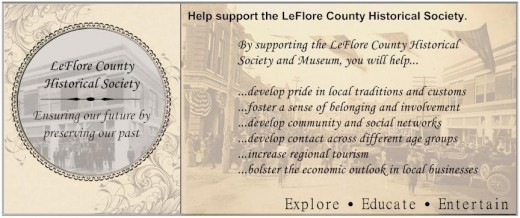- HubPages»
- Travel and Places»
- Visiting North America»
- United States
The LeFlore County Historical Museum
LeFlore County, in Southeastern Oklahoma, was once known as one of the most wild and rugged places in the country.
During the fourteenth century, a massive ancient Indian empire stretched from parts of eastern Oklahoma to the Atlantic Ocean. Known as the mound builders, The Caddo Indian built massive earthworks that supported entire cities. Today, traces of this ancient civilization can still be seen at Spiro Mounds just outside of Spiro, Oklahoma.
It was also during this time that another ancient race of European explorers could have potentially came into contact with the Caddo Indian. According to Gloria Farley, a Viking exploratory force arrived in Heavener, Oklahoma sometime around 1362. This group would have traveled around the tip of Florida, making their way along the coast until they came to the mighty Mississippi River. From there, it's entirely possible that they made the trek up the Mississippi and along the Arkansas in their explorations. In LeFlore County, they left their presence known with several runestones, many of which can still be seen today.
During the French occupation of what was the Louisiana Territory, fur traders and trappers roamed the land in a solitary existence, blazing trails through the wilderness and establishing camps throughout the area. One such camp was made at the base of Cavanal Hill, known as the highest hill in the world. From these camps, they would travel down the Poteau River to the Arkansas, and then down the Mississippi to New Orleans in order to sell or trade furs.
During the golden age of Outlaws, LeFlore County played host to hoard of notorious gunslingers, cattle rustlers, thieves, and anyone else seeking to escape the law. It is claimed that Frank and Jesse James, two of history's most legendary figures, had a secret stash of gold located somewhere in the mountainous areas that make up the southern end of LeFlore County. Until recently, a small hotel located on SugarLoaf Mountain was reported to be a favorite hangout of theirs. A few years later, Bell Starr, along with her outlaw gang, could be seen walking the streets of Poteau, acting as if she didn't have a care in the world. Even Bonnie and Clyde made an appearance in town. They didn't stay long; after robbing a local bank they quickly headed out of town.
Plans for the LeFlore County Historical Museum
Throughout history, LeFlore County has been the scene of many tragedies and triumphs. There are hundreds of stories to be told, each more fascinating than the last.
The LeFlore County Historical Society is dedicated to telling those stories. Even though the society has been in existence for many years, it wasn't until recently that they had a place to call home.
In 2008, the LeFlore County Historical Society acquired the old Lowrey Hotel building in historic downtown Poteau. Since then, the society has focused on upgrading the Lowrey into a world-class museum. The LeFlore County Museum, once renovations are complete, will house one of the largest collections of stories and artifacts found in Southeastern Oklahoma.
The LeFlore County Historical Society has already collected hundreds of artifacts ranging from the Viking Runestones and Caddo Indian pieces to 1960's memorabilia and railroad relics. These historic pieces are planned to be housed in different rooms of the LeFlore County Historical Museum, grouped according to date and significance. Since the museum is located in the old Lowrey Hotel, each comprehensive display will be housed in the original hotel rooms built back in the 1920's.
Current State of the Museum
Currently, this cannot be accomplished without further funds. Before the LeFlore County Historical Museum can be opened to the public, the building still needs a lot of work. First, and most importantly, the society must raise funds for a new heating and cooling system.
Once the heating and cooling system are installed, the artifacts that have remained in storage can be brought in. Additional funds are needed to create the informative displays and to ensure that the artifacts are properly protected. In addition, funds must also be raised in order to install elevators and ramps to make the museum accessible to everyone.
Currently, the museum is seeking government grants and private donations to help with this effort.
The LeFlore County Historical Museum, once completed, will be one of the most fascinating museums of it's type in Oklahoma. With the historical background of LeFlore County, the museum will become one of the most visited destination points in Southeast Oklahoma.

© 2012 Eric and Sierra Standridge







